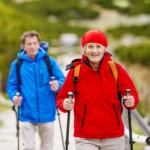This post may contain affiliate links or ads and we may earn a small commission when you click on the links at no additional cost to you. As an Amazon Affiliate, we earn from qualifying purchases. This is at no additional cost to you and helps with our website expenses.
Are you ready to hit the trail with confidence and style? Then it’s time to perfect your backpacking posture!
Backpacking posture refers to the way you hold your body while carrying a backpack on the trail. And as a woman (and especially older women), maintaining good posture is especially important.
Not only does good posture help prevent discomfort and pain, but it can also improve your balance, reduce your risk of injury, and help you enjoy your hiking adventure to the fullest.
But here’s the good news: you don’t have to go it alone. By using a backpack that promotes good posture, you can achieve the perfect form on the trail without sacrificing style or functionality.
So, in this post, we’ll be exploring tips and gear for maintaining good posture while backpacking. From choosing the right backpack to using trekking poles and other gear, we’ve got you covered. Let’s get started!
The Impact of Backpacking on Posture
Trailblazing can be tough on your posture, but don’t let that discourage you! Understanding the impact of backpacking on your posture is the first step in maintaining good form on the trail.
Let’s take a closer look at the common posture problems that backpackers face, why good posture is important, and the risks of poor posture.
Common Posture Problems While Backpacking
Have you ever found yourself hunching over your backpack or leaning too far forward on the trail? These are common posture problems that can cause discomfort and pain over time.
Here are a few other common posture problems backpackers face:
- Rounded shoulders
- Forward head posture
- Arching back
- Uneven weight distribution
The Importance of Maintaining Good Backpacking Posture
Maintaining good posture is crucial for preventing discomfort, pain, and injury while backpacking. Good posture allows for increased stability and balance on the trail, as well as improved breathing and circulation throughout the body.
Some of the benefits of good posture include:
- Reducing strain on your back, neck, and shoulders
- Improving your breathing and circulation
- Reducing your risk of falls and other injuries
- Enhancing your confidence and enjoyment of the trail
The Risks of Poor Backpacking Posture
Poor posture can lead to a range of health problems, both short-term and long-term. Some of the risks of poor posture while backpacking include:
- Lower back pain
- Neck pain and stiffness
- Shoulder pain and strain
- Knee and ankle problems
- Poor balance and stability
- Reduced endurance and performance
As you can see, maintaining good posture is essential for staying healthy and comfortable on the trail.
Tips for Maintaining Good Posture while Backpacking
Now that you know the importance of good posture while backpacking, let’s explore some tips for maintaining it.
These tips are designed to help you stay comfortable and healthy on the trail, so you can enjoy your backpacking adventure to the fullest. Here are six tips for maintaining good posture while backpacking:
Choose the Right Backpack
Choosing the right backpack is the first step in maintaining good posture. Look for a backpack that is designed to fit a woman’s body and provides good support for the hips and lower back.
The weight of the backpack should be evenly distributed across your back and hips to prevent strain.
Adjust the Straps
Adjusting the straps on your backpack is crucial for maintaining good posture. Make sure the hip belt is snug and sitting comfortably on your hips, and adjust the shoulder straps so that the pack is snug against your back.
Tighten the load-lifter straps to pull the weight of the backpack closer to your body.
Take Frequent Breaks
Backpacking can be strenuous, especially for older women. Taking frequent breaks to stretch and rest your muscles can help prevent fatigue and maintain good posture.
Aim for a 5-10 minute break every hour or so to stretch your legs, hips, and back.
Engage Your Core
Engaging your core muscles while backpacking can help maintain good posture and prevent lower back pain. Focus on tightening your abdominal muscles and keeping your spine straight. Imagine a string pulling you up from the top of your head and lengthening your spine.
When engaging your core, focus on tightening your abdominal muscles and keeping your spine straight. This will help distribute the weight of the backpack evenly across your body and reduce the strain on your lower back.
Practice tightening your core muscles before you hit the trail, and focus on engaging them throughout your backpacking adventure.
Best Backpacks that Promote Good Backpacking Posture
There are several backpack brands and models that are designed to promote good posture while backpacking. Here are some of the best backpacks for good posture:
Deuter Aircontact Lite 60+10 Backpack
Deuter Aircontact Lite 60+10 Backpack
The Deuter Aircontact Lite 60+10 backpack is a great option for those who need a large backpack for extended trips. This backpack is designed to provide good support for the back, hips, and shoulders, with a padded hip belt, lumbar support, and adjustable straps.
Osprey Aura AG 65 Backpack
Osprey Aura AG 65 Backpack
The Osprey Aura AG 65 backpack is designed specifically for women and is known for its excellent fit and comfort. This backpack features adjustable straps, a padded hip belt, and lumbar support, as well as a lightweight design that makes it easy to carry.
Gregory Deva 60 Backpack
Osprey Aura AG 65 Backpack
The Gregory Deva 60 backpack is designed for women and features a comfortable, supportive fit. This backpack has adjustable straps, a padded hip belt, and lumbar support, as well as a ventilated back panel that helps keep you cool on the trail.
Kelty Redwing 50 Backpack
Kelty Redwing 50 Backpack
The Kelty Redwing 50 backpack is a versatile backpack that is designed for both men and women. This backpack features a comfortable, supportive fit, with adjustable straps, a padded hip belt, and lumbar support. It also has a lightweight design that makes it easy to carry.
These backpacks are just a few examples of the many options available for promoting good posture while backpacking. When choosing a backpack, it’s important to consider the features listed above, as well as the size and capacity of the backpack. It’s also a good idea to try on different backpacks to see which one fits your body best.
Use Trekking Poles
Trekking poles can provide additional support and help distribute weight evenly, reducing the strain on your back and hips.
In order to achieve proper posture when using trekking poles, it is important to adjust the height of your poles to an appropriate level. Generally, the handles should be aligned with your wrists when your arms are bent at a right angle.
Additionally, you should adjust the length of your poles so that they do not get in the way of your strides while walking.
Finally, make sure that your arms are slightly bent while using the trekking poles because this will help to engage and strengthen your core muscles.
Stretch Before and After for the Best Backpacking Posture
Stretching is an important part of any backpacking adventure. Before hitting the trail, it is important to warm up your muscles with dynamic stretches that target your back, hips, and legs.
Examples include:
- Lunges
- Squats
- Toe touches
- Side leg raises
After a day on the trail, static stretching can help to reduce muscle tension and improve the range of motion. Try doing some lower back rotations and chest openers to counter the effects of long hours of walking with a heavy backpack on your spine and shoulders.
Additionally, focus on stretches like runner’s stretch, butterfly stretch, and hip flexor stretches to relieve tightness in the hips and legs.
Taking the time to properly stretch before and after backpacking can greatly reduce muscle soreness and fatigue throughout your journey.
Backpacks for Good Posture: How They Work
Maintaining good posture while backpacking is not just about how you carry your backpack. It’s also about the backpack itself.
A backpack that is designed to promote good posture can help you maintain the perfect form on the trail without sacrificing style or functionality.
Let’s take a closer look at the features of a backpack that promotes good posture, the benefits of using one, and how to choose the right backpack for you.
Features of a Backpack that Promotes Good Posture
A backpack that promotes good posture is designed to provide good support for the back, hips, and shoulders. Here are some of the key features to look for in a posture backpack:
- Adjustable straps: A backpack with adjustable straps allows you to customize the fit and distribute the weight of the pack evenly across your body.
- Padded hip belt: A padded hip belt can help reduce the strain on your lower back and hips.
- Lumbar support: A backpack with lumbar support can help keep your spine straight and prevent slouching.
- Lightweight: A backpack that is lightweight is easier to carry, reducing the strain on your body.
- Breathable materials: A backpack made from breathable materials can help prevent sweating and discomfort.
Benefits of Using a Backpack Designed for Good Posture
Using a backpack designed for good posture has many benefits, including:
- Reducing the risk of back, neck, and shoulder pain
- Improving balance and stability on the trail
- Enhancing endurance and performance
- Improving breathing and circulation
How to Choose a Posture Backpack
When choosing a posture backpack, there are a few key things to consider:
- Size and capacity: Choose a backpack that is the right size and has enough capacity to carry your gear.
- Fit: Look for a backpack that fits your body well and allows for a range of adjustability.
- Brand and reputation: Choose a reputable brand with good reviews from other backpackers.
- Features: Look for a backpack with the features listed above that promote good posture.
By choosing a backpack that is designed for good posture, you can achieve the perfect form on the trail without sacrificing style or functionality.
Backpacking Gear for Good Backpacking Posture
While a backpack designed for good posture is essential for maintaining the perfect form on the trail, other gear can also help improve your posture.
Let’s explore some other backpacking gear that can help you maintain good posture, including sleeping pads and pillows, footwear, and clothing.
Footwear for the Best Backpacking Posture
Good footwear is crucial for maintaining good posture while backpacking. Shoes or boots that fit well and provide good support can help reduce strain on your back, hips, and knees.
Look for footwear with the following features to improve your posture:
- Good arch support: Shoes or boots with good arch support can help distribute weight evenly and reduce strain on your back.
- Cushioned sole: A cushioned sole can help absorb shock and reduce the impact on your joints.
- Proper fit: Shoes or boots that fit properly can help prevent foot problems, which can in turn affect your posture.
When selecting footwear, try them on and walk around to ensure they are comfortable and supportive. It’s also a good idea to break in your shoes or boots before your backpacking trip to avoid blisters or other foot problems.
Sleeping Pads and Pillows for Better Backpacking Posture
Sleeping pads and pillows can also help improve your posture while backpacking. They can help cushion your back and hips, reducing the strain on your spine.
Look for a sleeping pad and pillow that are comfortable, supportive, and provide good cushioning.
Clothing
The clothing you wear while backpacking can also affect your posture. Loose clothing or clothing that restricts movement can make it harder to maintain good posture.
Choose clothing that is comfortable and allows for a range of motion. Look for moisture-wicking materials that will help keep you dry and comfortable on the trail.
By using the right footwear, sleeping pads, pillows, and clothing, you can improve your posture while backpacking and reduce the risk of discomfort, pain, and injury.
Common Posture Mistakes to Avoid
Maintaining a good posture while backpacking is not just about what you do, but also what you avoid.
Here are some common posture mistakes to avoid while backpacking.
Wearing a Backpack Improperly
Wearing a backpack improperly, such as slinging it over one shoulder, can cause strain and discomfort on your back and shoulders. Make sure to wear your backpack on both shoulders and adjust the straps properly.
Carrying Too Much Weight
Carrying too much weight in your backpack can cause strain and discomfort on your back, shoulders, and hips. Make sure to pack only what you need and distribute the weight evenly.
Slouching or Hunching
Slouching or hunching over your backpack can cause strain and discomfort on your neck, shoulders, and back. This is especially important for women, and especially older women, because they tend to have less muscle mass and bone density, making them more susceptible to posture problems.
I don’t mean to be redundant but this is soooo important. To avoid slouching or hunching:
- Focus on engaging your core
- Keep your spine straight
- Stand tall
- Keep your shoulder back
- Keep your chest up
- Tuck your chin in
- Bend your arms at a right angle
- Take frequent breaks to stretch
Improper Use of Trekking Poles
Improper use of trekking poles can also cause posture problems. Make sure to adjust the poles to the correct height for your body, and use them to provide additional support and balance on the trail.
Slouching or hunching is a common posture problem, especially for women and older women. This is because women tend to have less muscle mass and bone density, making them more susceptible to poor posture.
Slouching or hunching can cause strain on the neck, shoulders, and back, leading to discomfort and pain. By maintaining good posture on the trail and avoiding common posture mistakes, you can enjoy your backpacking adventure with confidence and comfort.
Final Thoughts on Backpacking Posture
Congratulations! You are now a posture pro! By understanding the impact of backpacking on your posture, learning tips and gear for maintaining good form, and avoiding common posture mistakes, you are well on your way to a comfortable and confident backpacking adventure.
Let’s recap what we’ve learned in this post.
Importance of Good Posture While Backpacking
Maintaining good posture is essential for preventing discomfort, pain, and injury while backpacking. Good posture can also improve your balance, stability, and overall performance on the trail.
Tips and Gear for Maintaining Good Backpacking Posture
To maintain good posture while backpacking, be sure to choose the right backpack, adjust the straps, take frequent breaks, engage your core, use trekking poles, and stretch before and after.
Additionally, other gear, such as footwear, sleeping pads and pillows, and clothing, can also improve your posture.
Encouragement for Older Women
Finally, we want to encourage older women to continue backpacking with good form. Backpacking can be a challenging and rewarding adventure, regardless of age.
With the right tips and gear, you can maintain good posture and enjoy the trail with confidence and comfort.
So, pack up your backpack, hit the trail, and remember to stand tall and proud. You’ve got this!









